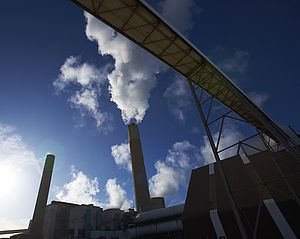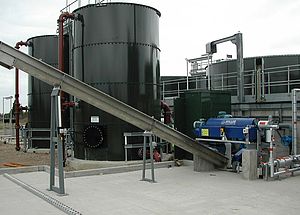Utilities are increasingly using technologies designed to help extract energy and other valuable products from wastewater sludge. This development makes sound economic as well as environmental sense. Sewage sludge from wastewater has long been viewed as an expensive nuisance, fit only for treatment and disposal. However, new regulations as to its disposal, preventing dumping at sea or in landfill, have forced a major rethink. Sewage contains 10 times the amount of energy needed to treat it; and it is technically feasible to recover energy from sludge. As a renewable energy source, it can be used directly in wastewater treatment, reducing a facility’s dependency on conventional electricity, or as a fossil fuel substitute supplying the power utility cement and mineral processing industries with a secondary fuel source in lieu of coal, to reduce emissions of greenhouse gases. Using solids as a resource, rather than a waste, may help stressed public budgets as well. However, as with any energy from waste (EFW) operation, there are costs involved. Wastewater solids must be processed prior to disposal, and solids handling accounts for as much as 30% of a wastewater treatment facility’s costs. As with all forms of energy, continuity of supply is paramount. This means that the plants that process sewage sludge into pellets or granulate are continuous operations that cannot stop for adhoc repairs and refurbishment. Militating against achieving 24/7 operation is the nature of the sludge itself. On its passage through sewers, sewage becomes contaminated with flood debris, sand, grit, deposits from environmental structures, residue from the land mass, plus metallics, and plastics. Sand and grit, in particular, are a major problem, due to their high silica content. They are highly abrasive, causing problems of wear and erosion with the equipment used to treat and process the sludge: equipment such as pipework, augers, screw casing, mixers, blenders, driers, separators, screens, centrifuges, mechanical conveyors, presses, driers, ducting, filters housings, fans and fan casings. All of this equipment can benefit from wear protection in order to deliver overall systems that reduce erosion and cavitation and improve material flow. However, a survey by wear protection specialist, Kingfisher Industrial, has found that wear protection isn’t optimised to its full benefit, and that water industry awareness of the cost and operational benefits of wear protection in the processing of wastewater and sludge is minimal. “We have identified that the vast majority of waste and water treatment plants depend on the use of heavier grades of stainless steel to counter both the corrosive and abrasive effects of handling and treating waste water and sludge,” said John Connolly, MD of Kingfisher. “In an attempt to improve the life expectancy of critical plant and equipment, some processors have utilised polymeric composites and glass flake coatings, which can be applied by brush, trowel or be sprayed on. They have also undertaken the process of applying hard metal deposits by means of traditional welding methods and, albeit these processes are in some instances suitable, they are by no means an ideal fit for many areas of the process. In some instances, these methods of protection have extended the service by an improved margin; however, they do not eradicate the continual problems experienced in many applications. Overall, we think that these problems are the result of the EFW process being so new; hence, the awareness of suitable technology solutions to reduce wear and corrosion, cut maintenance costs and optimise the whole life costs of plant is limited.” Kingfisher has calculated that, on average, users of its wear protection systems – Polymer, Ceramic and Metallic - benefit by a factor of at least 5 times their initial outlay, with many installations benefiting from wear life of up to 20-years following appropriate wear treatment. “It is far more profitable for companies in continuous process industries to employ suitable wear protection than having to provide maintenance and repair of equipment at regular intervals, due to problems associated with wear and corrosion,” said John Connolly. “Reduced maintenance means reduced risk, reduced cost and generates more production uptime over longer periods – all of which are critically important to improve the efficiencies of companies that operate 24/7.” Wear protection can be employed at any time in the life of a process system. However, if a system is designed with wear protection from its conception, then overall equipment costs can usually be reduced, as the system chosen to protect the equipment can often remove the requirement to manufacture components using heavier grades of material. Take a pipeline, for example: if a wear protection lining system is used, then the user can specify thinner walled pipe, as the lining will provide the protection. This might mean 5mm wall thickness for the pipe rather than 10mm, with a commensurate 50% saving in cost. This downsizing is possible because the pipework becomes a carrier for the wear resistant lining, the synergy of the two meeting the requirements for pressure, temperature and wear protection. A process plant that is equipped with a well designed wear protection system also offers additional benefits, in that the process operator has little or no maintenance requirements over the lifetime of the installation. This means no ongoing cost problems of interruptions to production as a result of breaking down pipework for maintenance at regular intervals. It also means that no specialist labour is required, avoiding the safety risks of personnel working at height, performing hot work and lifting operations. Also avoided are the tasks of organising access platforms and plant hire, with their attendant costs – and risks; and those of devising clean up procedures for any spillages that can occur when process pipework is perforated, thus creating an environmental issue or potential breach of legislation. As a result, the system user benefits from continuous operational gains which defray the cost of the protection system, guaranteeing a prompt return on investment. "The requirement for green energy means that the demand for energy from waste can only grow,” said John Connolly. The technology for processing sludge is still relatively new, so treatment plants have a breathing space in which to adopt best practice in wear protection, ensuring that their processing effort in supplying highly demanding market sectors, such as steel, cement and power generation, is as reliable, continuous and cost effective as possible.”




















